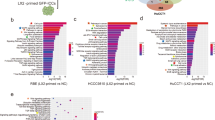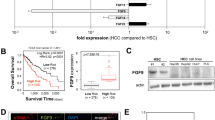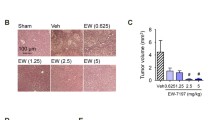Abstract
Hepatic stellate cells play a role in the migration process of hepatocellular carcinoma cells. Here, we address the role of the stromal-derived factor-1/CXC chemokine receptor 4 (SDF-1/CXCR4) axis on hepatocellular carcinoma progression. The expression of the SDF-1 and the CXCR4 was determined through western blotting and real-time PCR analysis using hepatic stellate (LX02) and hepatocellular carcinoma (MHCC97, SMMC7721, Hep3B, and HepG2) cell lines depleted of CXCR4 using shRNA. The migration of hepatocellular carcinoma cells following exogenous treatment with SDF-1 or in co-culture cell systems was measured using the Transwell assay. In parallel, the expression of epithelial–mesenchymal transition (EMT) markers was also determined. We found that SDF-1 is highly expressed in the hepatic stellate cell line LX02 and that the hepatocellular carcinoma cells express high levels of CXCR4. Co-culturing hepatocellular carcinoma cells with LX02 or exogenous treatment with SDF-1 induced an EMT as shown by increased migration. In contrast, ablation of CXCR4 expression in HepG2 cells attenuated the migration of HepG2 cells and suppressed the EMT. Thus, hepatic stellate cells can promote hepatocellular carcinoma cell invasion through the SDF-1/CXCR4 axis.





Similar content being viewed by others
References
Schafer DF, Sorrell MF (1999) Hepatocellular carcinoma. Lancet 353:1253–1257
Zhang Y, Li L, Wang Y et al (2007) Downregulating the expression of heparanase inhibits the invasion, angiogenesis and metastasis of human hepatocellular carcinoma. Biochem Biophys Res Commun 358:124–129
Shariff MI, Cox IJ, Gomaa AI et al (2009) Hepatocellular carcinoma: current trends in worldwide epidemiology, risk factors, diagnosis and therapeutics. Expert Rev Gastroenterol Hepatol 3:353–367
Wang ZG, Zhang GF, Wu JC et al (2013) Adjuvant therapy for hepatocellular carcinoma: current situation and prospect. Drug Discov Ther 7:137–143
Devaud C, John LB, Westwood JA et al (2013) Immune modulation of the tumor microenvironment for enhancing cancer immunotherapy. Oncoimmunology 2:e25961
Mace TA, Bloomston M, Lesinski GB (2013) Pancreatic cancer-associated stellate cells: a viable target for reducing immunosuppression in the tumor microenvironment. Oncoimmunology 2:e24891
Zhang Z, Guo Y, Zhang S et al (2013) Curcumin modulates cannabinoid receptors in liver fibrosis in vivo and inhibits extracellular matrix expression in hepatic stellate cells by suppressing cannabinoid receptor type-1 in vitro. Eur J Pharmacol 721:133–140
Coulouarn C, Corlu A, Glaise D et al (2012) Hepatocyte-stellate cell cross-talk in the liver engenders a permissive inflammatory microenvironment that drives progression in hepatocellular carcinoma. Cancer Res 72:2533–2542
Zhao W, Zhang L, Yin Z et al (2011) Activated hepatic stellate cells promote hepatocellular carcinoma development in immunocompetent mice. Int J Cancer 129:2651–2661
Wang B, Wang W, Niu W et al (2014) SDF-1/CXCR4 axis promotes directional migration of colorectal cancer cells through upregulation of integrin alphavbeta6. Carcinogenesis 35:282–291
Schaefer UW, Schmidt CG, Dicke KA et al (1975) Cryopreservation of hemopoietic stem cells. Cancer research and clinical oncology 83:285–291
Conley-LaComb MK, Saliganan A, Kandagatla P et al (2013) PTEN loss mediated Akt activation promotes prostate tumor growth and metastasis via CXCL12/CXCR4 signaling. Mol Cancer 12:85
Sun X, Cheng G, Hao M et al (2010) CXCL12/CXCR4/CXCR7 chemokine axis and cancer progression. Cancer Metastasis Rev 29:709–722
Singh A, Settleman J (2010) EMT, cancer stem cells and drug resistance: an emerging axis of evil in the war on cancer. Oncogene 29:4741–4751
Qu C, Zhang W, Zheng G et al (2014) Metformin reverses multidrug resistance and epithelial-mesenchymal transition (EMT) via activating AMP-activated protein kinase (AMPK) in human breast cancer cells. Mol Cell Biochem 386:63–71
Zhao L, Li W, Zang W et al (2013) JMJD2B promotes epithelial-mesenchymal transition by cooperating with beta-catenin and enhances gastric cancer metastasis. Clin Cancer Res 19:6419–6429
Yamada S, Fuchs BC, Fujii T et al (2013) Epithelial-to-mesenchymal transition predicts prognosis of pancreatic cancer. Surgery 154:946–954
Liu L, Wang LL, Yu XG et al (2013) Epithelial-mesenchymal transition in prostate cancer. National journal of andrology 19:360–364
Wang Z, Ma Q, Liu Q et al (2008) Blockade of SDF-1/CXCR4 signalling inhibits pancreatic cancer progression in vitro via inactivation of canonical Wnt pathway. Br J Cancer 99:1695–1703
Lei J, Ma J, Ma Q et al (2013) Hedgehog signaling regulates hypoxia induced epithelial to mesenchymal transition and invasion in pancreatic cancer cells via a ligand-independent manner. Mol Cancer 12:66
Schmittgen TD, Livak KJ (2008) Analyzing real-time PCR data by the comparative C(T) method. Nat Protoc 3:1101–1108
Mohla S (2007) Tumor microenvironment. J Cell Biochem 101:801–804
Xia Y, Chen R, Ye SL et al (2011) Inhibition of T-cell responses by intratumoral hepatic stellate cells contribute to migration and invasion of hepatocellular carcinoma. Clin Exp Metastasis 28:661–674
Liu H, Pan Z, Li A et al (2008) Roles of chemokine receptor 4 (CXCR4) and chemokine ligand 12 (CXCL12) in metastasis of hepatocellular carcinoma cells. Cell Mol Immunol 5:373–378
Chu H, Zhou H, Liu Y et al (2007) Functional expression of CXC chemokine recepter-4 mediates the secretion of matrix metalloproteinases from mouse hepatocarcinoma cell lines with different lymphatic metastasis ability. Int J Biochem Cell Biol 39:197–205
Gentilini A, Rombouts K, Galastri S et al (2012) Role of the stromal-derived factor-1 (SDF-1)-CXCR4 axis in the interaction between hepatic stellate cells and cholangiocarcinoma. J Hepatol 57:813–820
Sutton A, Friand V, Brule-Donneger S et al (2007) Stromal cell-derived factor-1/chemokine (C-X-C motif) ligand 12 stimulates human hepatoma cell growth, migration, and invasion. Mol Cancer Res 5:21–33
Balabanian K, Lagane B, Infantino S et al (2005) The chemokine SDF-1/CXCL12 binds to and signals through the orphan receptor RDC1 in T lymphocytes. J Biol Chem 280:35760–35766
Boldajipour B, Mahabaleshwar H, Kardash E et al (2008) Control of chemokine-guided cell migration by ligand sequestration. Cell 132:463–473
Mimeault M, Batra SK (2011) Frequent gene products and molecular pathways altered in prostate cancer- and metastasis-initiating cells and their progenies and novel promising multitargeted therapies. Mol Med 17:949–964
Bertran E, Crosas-Molist E, Sancho P et al (2013) Overactivation of the TGF-beta pathway confers a mesenchymal-like phenotype and CXCR4-dependent migratory properties to liver tumor cells. Hepatology 58:2032–2044
Acknowledgments
This study was supported by the National Natural Science Foundation of China (No. 81201824) and by the Fundamental Research Funds for the Central Universities (No. XJTU-2013-01).
Author information
Authors and Affiliations
Corresponding author
Additional information
Xuqi Li and Pei Li have contributed equally to this study.
Rights and permissions
About this article
Cite this article
Li, X., Li, P., Chang, Y. et al. The SDF-1/CXCR4 axis induces epithelial–mesenchymal transition in hepatocellular carcinoma. Mol Cell Biochem 392, 77–84 (2014). https://doi.org/10.1007/s11010-014-2020-8
Received:
Accepted:
Published:
Issue Date:
DOI: https://doi.org/10.1007/s11010-014-2020-8




